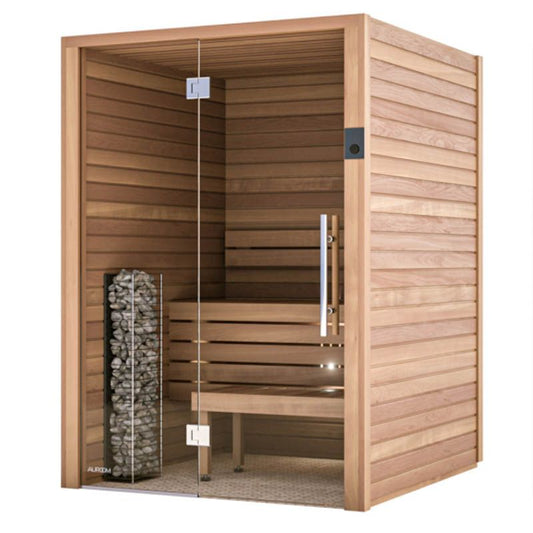Things about Traditional Sauna
Things about Traditional Sauna
Blog Article
Not known Facts About Traditional Sauna
Table of ContentsThe 2-Minute Rule for Traditional Sauna10 Simple Techniques For Traditional SaunaSee This Report about Traditional SaunaLittle Known Facts About Traditional Sauna.
A lot of the weight lost in a sauna is water loss and is re-gained upon rehydrating. Without an uncertainty sauna can be an important part of a healthy and balanced weight loss program. To take a look at the differences in between typical and IR saunas, I will divide these right into proven, academic, and produced differences.Therefore, the most popular factor in the saunawhich is at the ceiling straight above the sauna heateris usually between 185 and 190 F. Traditional Sauna. Claims that a standard sauna exceeds 200 F is merely not real and not relevant for electric saunas marketed in the United States. The temperature for a far-infrared sauna is usually established in between 120 and 140 F; however, unlike the traditional sauna, the goal in and IR space is not to attain a heat
Due to this, the temperature level difference is practically irrelevant, since extreme sweating causes both sauna kinds, yet the technique of heating the body is different. In an IR sauna the bather will certainly feel warm and will certainly sweat profusely, yet at much lower temperature levels. Hence, if the goal is to spend longer time periods in the sauna, the IR sauna is an excellent selection.

The smart Trick of Traditional Sauna That Nobody is Discussing
When the heat is achieved, the aspects cycle on and off to maintain the high temperature. The majority of conventional sauna users delight in pouring water over the rocks to develop heavy steam to raise sauna humidity levels. The advantages of pouring water over the rocks consist of: making the space extra comfy, dampening the nasal passages, and allowing the use of aromatherapy by blending crucial oils with the water.
In a far-infrared sauna, the warmth waves permeate the body to properly heat up the body and increase the body core temperature level. To achieve this raised temperature, Far-infrared emitters produce infrared power which is close to the visite site same wavelength as that which the body naturally emitsoften described as the "Essential Array" of 7 to 14 microns), so the energy is well gotten by the body.
When the power gets in the body, it causes the body temperature to boost and eventually causes perspiration. In an infrared sauna it's crucial for the emitters/heaters to stay on virtually regularly. Considering that there is no mass of rocks to retain warmth, the sauna will certainly cool if the emitters turned off.
As mentioned over, the sauna bather in an infrared room wants to position himself before operating emitters to get maximum advantage from the heat. The home heating time for both rooms can be really different, depending on how the spaces are utilized. For a typical sauna, a bather must allow 30-40 minutes for the area to attain a preferred temperature and to effectively pre-heat the rocks.
An Unbiased View of Traditional Sauna
A well built sauna will commonly accomplish investigate this site a temperature level of 150-160 F in regarding 30-40 minutes. For hotter temperature levels, the area may require to warm for a longer period.
To some, 15 mins was "squandered" while the infrared power heated the timber panels instead than warming a body, while others locate a pre-heated area to be more comfy and believe a raised beginning temperature is essential to begin perspiring. The length of advised usage for each area is about the very same (10-15 mins per session); nevertheless, because of the lower air temperatures and the capacity to feel the results of infrared warmth faster than a standard sauna, it is not unusual for an individual to invest a total of 20-30 mins in an infrared sauna.
Conventional saunas often tend to be bigger (for this reason make use of more electrical energy) than infrared saunas, although conventional saunas are absolutely offered in one and two individual sizes. For a two-person traditional sauna, 5x6 or 5x7 size is most prominent. The leading bench can easily seat two or 3 people and is additionally long enough to lie down throughout the sauna session.


The ordinary cost per kWH of electrical energy in the united state is about $0.11, so a 4.5 kW heater will certainly set you back roughly $.50 to run for one hour, if the heating unit runs continuously for one hour. Generally a sauna heating unit will run for 75% of the very first hour and 50% of succeeding hours on considering that the aspects cycle once the set temperature is attained.
Traditional Sauna Things To Know Before You Buy
A two person far-infrared area is usually physically smaller than a conventional sauna, typically concerning 4' x 4' or smaller sized. The IR furnace is commonly Get the facts 1.5-1.7 kW using a 120 volt 15 amp plug-in service. Since the room can be made use of quicker than a sauna room, we will certainly presume the area is made use of for to of an hour including warm up time.
Finally, there is a rarely gone over difference in the social experience between both areas. While our culture has lost some of the social advantage of the traditional sauna experience, it can be extremely socially fulfilling. From household time in the sauna, to heart-felt discussions with better halves, to sauna partiesthe conventional sauna experience can lead to intimate socializing.
A lot of higher end infrared areas include colored light therapy, noise systems and full-glass fronts.
Report this page